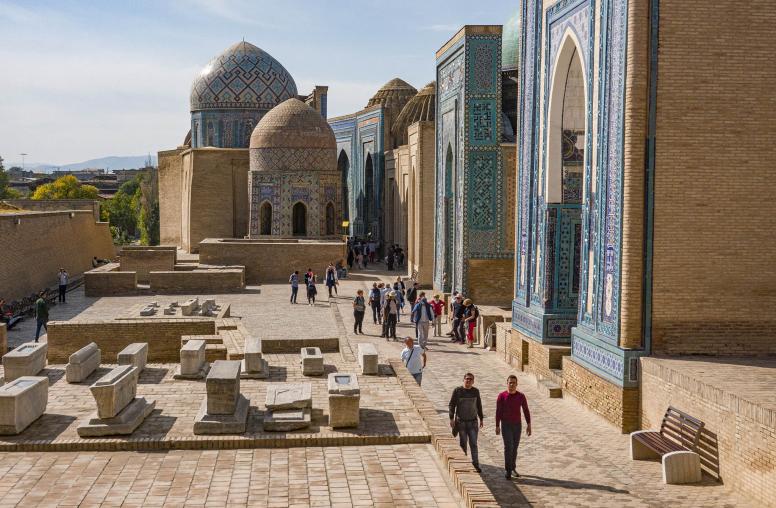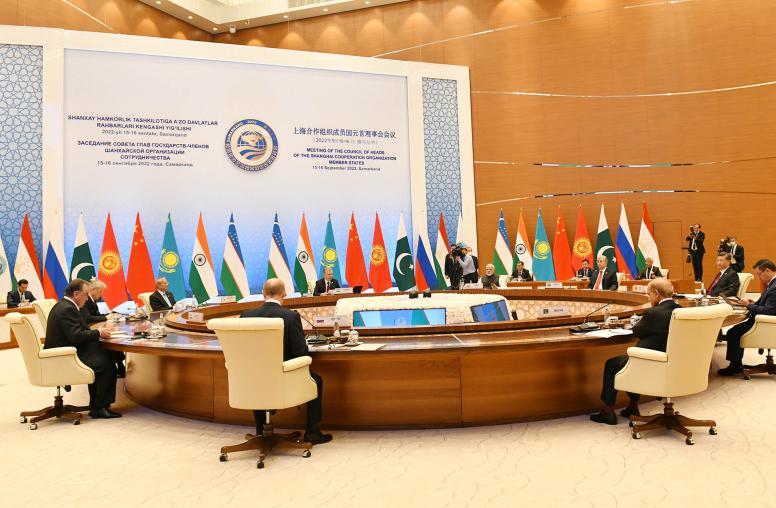New Central Asian Leaders Look to Balance Relations with Major Powers
By cooperating with one another, Central Asian leaders seek agency in a shifting geopolitical and economic landscape.
For the first time ever, all five presidents of the Central Asian republics (Kazakhstan, Kyrgyzstan, Tajikistan, Turkmenistan and Uzbekistan) met in-person with a U.S. president as part of “C5+1” summit on the sidelines of last week’s U.N. General Assembly.

However, this was not the only time Central Asian leaders have gotten together recently — they have been on something of a “C5+” summit road show over the past year-and-a-half. The tour started in January 2022, when they held a virtual summit with Indian Prime Minister Narendra Modi. Next came an October 2022 meeting with Vladimir Putin in Kazakhstan, followed by a November summit with Turkish President Recep Tyyip Erdogan in Uzbekistan (this meeting did not include Persian-speaking Tajikistan).
Last May, the five leaders traveled to Xian, China, to meet with Xi Jinping. In June, they met with the European Union in Kyrgyzstan and then travelled to Saudi Arabia for a summit with the Gulf Cooperation Council in August.
This summit tour has been something of a coming-out affair for a new generation of political leadership in the region, with four of the five Central Asian presidents having taken office since 2016. This collective engagement among the region and with the world also shows a real commitment from the C5 to a “multi-vector” foreign policy that attempts to maintain good relations with all its neighbors. For small- to medium-sized landlocked countries in a rough neighborhood, this policy makes a lot of sense.
The Limits of Regional Cooperation
The C5, being located between Russia, China, Iran and Afghanistan, are a case study in strategic complexity. On top of that, the arid and landlocked region faces pressing issues such as severe climate change, increasing water scarcity, and dependence on hydrocarbon and labor exports.
In short, the leaders of the five Central Asian republics have a lot to talk about — something we’ve seen more of in recent years. Just days before heading to New York for the U.N. General Assembly, they met in Dushanbe, Tajikistan, for the fifth meeting of what they call the annual “Consultative Meeting of the Heads of State of Central Asia.”
Getting to regional solidarity, much less integration, has not been easy. The regional presidential consultative meetings like the one in Dushanbe are an attempt by the leaders of the C5 to come together without an outward facing “plus one” like Russia, China or the United States.
When they met last year, they discussed an ambitious treaty proposed by Kazakhstan to bring the five countries closer together to solve their own problems internally and to present a more united front to the world. While Kazakhstan, Uzbekistan and Kyrgyzstan signed the treaty at the meeting, Tajikistan and Turkmenistan demurred, saying they would reconsider after consultations at home.
This year, the leaders came prepared with many good talking points. Kazakhstan and Uzbekistan, by far the largest economies in the region, proposed a series of initiatives for regional cooperation, if not quite integration. Meanwhile, Turkmenistan offered to sell more of its abundant natural gas to the region.
The meeting’s final communique hit all the right notes — especially on climate change, regional trade and transit, and engaging Afghanistan — but broke little new ground. Notably, the meeting did not revisit last year’s regional treaty, which many analysts in the region thought would finally be signed by Tajikistan and Turkmenistan this time around. There was also no public discussion or statement on Russia’s invasion of Ukraine, China and the Uyghurs, or the border conflict between two members of the C5, Tajikistan and Kyrgyzstan. Instead, the meeting opted for informality over the treaty-signing of last year.
A Historic Meeting with President Biden
Four days later, the C5 presidents arrived in New York for the U.N. General Assembly, where they met briefly with President Biden on September 19 for the first head-of-state-level meeting between Central Asia and the United States. This historic meeting marks the latest in Washington’s increasing engagement after Secretary of State Antony Blinken’s trip to the region in March.
The C5+1 Leaders’ Joint Statement that came out of the meeting with President Biden covers a broad range of issues and sets an agenda for what comes next in the U.S. relationship with the region. It reaffirms a commitment to independence, sovereignty and territorial integrity for all countries under the U.N. Charter and supports regional efforts to find local solutions to their own problems, as well as efforts to stabilize and deal with threats emanating from Afghanistan and develop the security dialogue more broadly.
On the economic front, the statement supports the creation of a new corridor for trade, getting energy to market, and promises more investment in the region’s infrastructure — especially clean energy and other projects to help mitigate the effects of climate change. Additionally, it promises much greater engagement in cultural and educational exchanges.
What’s striking, however is that the joint statement from the C5+1 meeting with President Biden says almost all the same things as the various joint statements from C5 meetings with India, Russia and China. The direction of the trade corridor is obviously different in the other versions, and the one with Russia has a few more edgy statements about the world order. The Xi’an Declaration from the China-Central Asia Summit also had some nice things to say about the Chinese Communist Party’s historic role in the region.
But for the most part, all these statements echo each other with slightly different spins. While it’s tempting to see this as Central Asian leaders contradicting themselves, the statements’ similarities actually confirm their deep commitment to a truly multi-vector foreign policy and rejection of zero-sum thinking in the competition between great (and medium) powers in the region.
Each of the “+1” partners would like a Central Asian region that embraces their own positions more closely, but Central Asian countries are keeping all the doors open. It may be that this approach is one they all very much agree on. All five leaders are now heading to Berlin to meet with the German chancellor this week to continue the tour.
What Comes Next for Central Asia?
The Central Asian presidents face some common big challenges going forward. They have been playing a difficult game in maintaining this “multi-vector” friends-with-all foreign policy alignment — especially in the conflict between Russia and Ukraine, where they’re trying to maintain their vital economic relationship with Russia while also trying to avoid running afoul of sanctions against Russia.
The region relies on Russia as a trading partner, as a destination for migrant laborers, and for getting its hydrocarbons to market. It has so far avoided condoning Russia’s invasion of Ukraine, and some countries have shown some pushback. But the Russian economy has not collapsed, and labor remittances, while down, have not dried up. In fact, the region, if anything, has become even more economically enmeshed with Russia as hundreds of thousands of Russians, both well-off technology workers and draft dodgers, have fled to Central Asia to sit out the war.
But Central Asian countries, especially Kazakhstan, are aware that victorious Russian expansionism may eventually target them as well, as former Russian President Dmitri Medvedev made clear in a controversial post last year.
With the war settling into a stalemate, Central Asian countries will be looking at the West — and the United States in particular — for some relief on sanctions, support in reconnecting to the outside world in ways that are not so dependent on Russia, and even for some clarification on how the West can reassure Central Asia on security issues. While some European parts of the former Soviet Union (the Baltic States, Ukraine, Moldova and Georgia) are on the Euro-Atlantic map and may end up as part of new Western security agreements after the war in Ukraine ends, there has been no such consideration of the long-term security of Central Asia.
Amid the backdrop of resurgent great power competition, the increasing involvement of regional rivals Turkey, Iran, India, the Gulf Cooperation Council and China create a very fluid and complex chess board in Central Asia, and Central Asian countries are trying to be more than pawns in this game.
Increasing regional solidarity and coordination makes succeeding in this more likely. Regardless of how the conflict in Ukraine ends, or how the situation in Afghanistan develops, they stand a better chance together than as rivals. This is where Central Asians themselves can find agency in a difficult world.
What the U.S. Can Offer Central Asia
In the end, both the recent Dushanbe meeting and the C5+1 meeting in New York were symbolic and important mostly for the fact that they took place at all, rather than that they broke new ground.
Moving forward, the United States should seek to reassure Central Asia that it is committed to the region even though it is unable to really offer concrete security guarantees or economic engagement on anything approaching the scale of Russia and China.
Secretary Blinken’s trip earlier this year struck the right tone by not asking the C5 to choose between Russia and the West or between China and the West, but by offering a helping hand. The brief meeting with President Biden upgraded the relationship, but it won’t change the fact that U.S. leverage post-Afghanistan and post-Ukraine is at a low point in the region. In the coming years, the United States should find support to offer the region that it can deliver on and others cannot, such as:
- Work with Congress to free the remaining countries of Central Asia from the 1974 Jackson Vanik Amendment, a law designed to punish the Soviet Union on Jewish immigration issues that is still on the books but has been waived for Russia.
- While still working to transport oil and gas from the region through the Caspian Sea to world markets in the short term, the United States can also work with Central Asian countries on technologies that provide them with replacements for oil and gas exports in the long run — including by helping Kazakhstan, which has some 40 percent of the world’s uranium reserves and an abundance of rare Earth minerals, find a bigger role for their processing.
- Help the region deal with its Afghanistan problems, which are more tied to a sustainable economy, countering ISIS-K, reducing drug trafficking, and sharing water resources in a region heavily impacted by climate change.
- While planning for security arrangements after the end of Russia’s war in Ukraine, find a way to include Central Asia. The United States should consider revitalizing some kind of formal engagement on security like the now-defunct Partnership for Peace.



